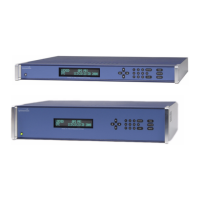138 XLi Time & Frequency System
XLi-man, Issue 8, 6/17/2008, Rev. H
SSSSSSSSSSSS SSSSSSSSSS SSSSSSS S SSS S SSSSS S
1
Keypad
• J1 Configuration: (IRIG-A, IRIG-B, NASA 36, TIET) Set to match the type of time code input.
• J1 Time Reference (Available when J1 Configuration is IRIG-A, IRIG-B, NASA 36, not for TIET):
(Primary, Secondary, Standby) Identify the time code input as a primary or secondary reference
source. The function, “F74 – Clock Source Control” on page 107
, uses this designation to for
reference source switching. Standby disables and removes J1 Input as a valid reference source.
Selecting Primary or Secondary automatically bumps another reference source with the same
setting (e.g. F119 – GPS Receiver Configuration) to Standby.
Note: Configuring F110 for TIET forces J1 Time Reference to Standby. When reconfiguring the J1 as a
time code reference source input, be sure to set J1 Time Reference to Secondary or Primary.
• Configure Code: (AM, DC) Set to the time code input signal type: AM for amplitude modulated,
or DC level shift. See the time code definitions in “E: Time Code Formats” on page 287
for more
information.
• Input Impedance: Always use 50Ω coaxial cable and terminate it into a 50Ω load.
• Input Polarity: Positive, Negative
• Propagation Delay: (Range 0 to 99999 μS in 1 μS steps) (Factory setting: 1 μS) Compensates
for delay caused by cable length on the J1 input.
• IRIG Mode: (Sync Gen)
• Error Bypass: (Off, 1-10 Frames) (Factory setting: 3 frames) Is used when the IRIG input is
intermittent or has a low signal to noise ratio (SNR). This allows the time code input to ‘flywheel’
for the specified number of invalid time code frames before F110 generates an alarm. Off means
the F73 IRIG input alarm will alarm on the first invalid time code frame. 1-10 means the F73 IRIG
input alarm will alarm after it detects 1-10 consecutive invalid time code frames.
When TIET is selected for J1 Input Configuration, F110 presents the following series of choices:
• Input Impedance: 50Ω / 100κΩ.
• Input Polarity: Positive only
Upon changing the settings, the last display prompt asks:
• Save Changes?: (Yes, No) Yes applies the changes. No cancels the changes.
For J1 specifications, see “J1 Input – Time Code or Time Interval - Event Time” on page 9
.
Notes:
• Time Code: The XLi expects time code input that provides UTC in 24-hour format. If the time
code does not provide UTC in 24-hour format (e.g., it uses standard, local, or GPS time, or is in
12-hour format), the XLi’s internal clock will be set to the wrong time when it uses the time code
reference, and its time outputs will be similarly affected.
• Time Code: IRIG and NASA 36 time code don’t contain “year” information. Enter the current year
using F3 before using IRIG as a primary or secondary reference source. Failure to do so can
cause the incorrect time information to be distributed. See “F3 – Time & Date” on page 50
.
• At the end of the year, the year increments by one (e.g., 2004 -> 2005), provided the XLi is
Artisan Technology Group - Quality Instrumentation ... Guaranteed | (888) 88-SOURCE | www.artisantg.com

